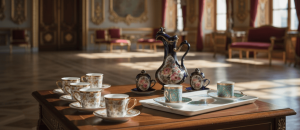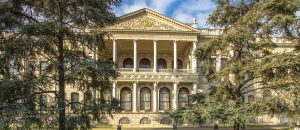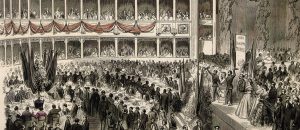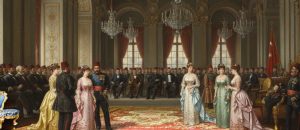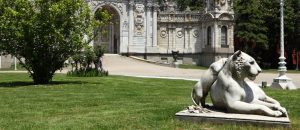Visiting Dolmabahçe Palace is much more than just walking through beautiful rooms and taking photographs; it is “reading” a colossal book that narrates the greatest transformation story of an empire through its walls, ceilings, and furniture. Instead of merely “visiting” as an ordinary tourist, you need the right keys to “read” it like a curator. Here are 5 fundamental tips for deciphering the subtext, symbols, and hidden messages of Dolmabahçe Palace. These keys will transform your trip into an intellectual and emotional journey of discovery.
Tip 1: Look for Symmetry (The Language of Balance and Order)
What Should You Look For?: As you walk inside the palace, constantly search for symmetry and balance. Does a door, window, or fireplace on the right side of a hall have a counterpart on the left side? Does the ceiling decoration revolve around a center? Is the furniture arranged according to an axis? You will see this principle very clearly, especially [Link: on the facade facing the sea -> /iki-yuzlu-saray-dolmahce-cephelerinin-anlattigi-siyasi-hikaye] and in the Ceremonial Hall (Muayede Salonu).
Why Is It Important?: Symmetry is not just an aesthetic preference. In 19th-century Western architecture, symmetry is a symbol of reason, order, rationality, and control. Unlike Topkapı Palace’s labyrinthine, organic structure, Dolmabahçe’s perfect symmetry is a conscious political statement broadcasting the message: “We are now a predictable and modern state, based on laws and rules, not on traditions.” Everywhere you see symmetry, you see the spirit of the Tanzimat reforms.
Tip 2: Notice the Dilemma of Splendor and Debt (The Price of Glitter)
What Should You Look For?: Notice the dazzling crystal chandeliers, the ceiling decorations using tons of gold, the highest quality marbles, and the most luxurious furniture. But at the same time, ask yourself: “What was the price of all this glitter?”
Why Is It Important?: Dolmabahçe’s excessive splendor is as much a “show of force” as it is a product of a “weakness complex.” During a period when the Empire was referred to as the “Sick Man,” this excessive spending was a prestige project aimed at Europe. However, this splendor marked the beginning of a spending spiral that led the empire to [Link: its first foreign debts in history -> /bir-hayalin-bedeli-sultan-abdulmecid-dolmahceyi-neden-yaptirdi-ve-imparatorluga-neye-mal-oldu] and ultimately to economic bankruptcy with the Public Debt Administration (Duyun-u Umumiye). In every gold leaf you see, you can read both the empire’s claim of power and the seeds of its approaching collapse.
Tip 3: Observe the State’s Showcase (The Selamlık vs. Harem Difference)
What Should You Look For?: Pay attention to the architectural and decorative differences between the Selamlık (the section where state affairs were conducted) and the Harem (the Sultan’s private living area) sections of the palace. Question why the halls in the Selamlık (Ambassador’s Hall, Red Chamber) are more monumental, more official, and less personal, while the rooms in the Harem have a more “lived-in,” smaller-scale, and more intimate atmosphere.
Why Is It Important?: This difference demonstrates how sharply the separation between public space and private space intensified in the 19th century. The Selamlık is the “state’s showcase” displayed by the empire to the world. Every detail here is designed to impress foreign ambassadors and demonstrate power. The Harem, on the other hand, is the place where the dynasty’s private life occurred, subject to less protocol. Comparing these two sections allows you to understand the difference between a state’s public identity and its private life.
Tip 4: Observe the Transformation of Privacy (Windows and Furniture)
What Should You Look For?: Focus on the palace’s enormous windows and the relationship these windows establish with the outside world. Consider why the “lattices” found at Topkapı are absent here. Observe how [Link: seats and chairs -> /tahtlar-koltuklar-ve-konsollar-dolmahcenin-mobilyalari-guc-ve-konforu-nasil-yeniden-tanimladi] that elevate people above the floor have replaced the traditional floor cushions (sedirs).
Why Is It Important?: These two elements narrate the revolution in the understanding of privacy and individuality. Large windows without lattices show that the Harem is no longer completely isolated from the outside world but is opening up to the world in a controlled manner. Chairs, on the other hand, herald the transition from a communal seating arrangement to a new social structure that centers the individual. These details allow you to read how Westernization transformed even the most basic living habits.
Tip 5: Feel Atatürk’s Legacy (The Power of Simplicity)
What Should You Look For?: After touring all the splendor of the palace, enter [Link: Room Number 71 -> /71-numarali-oda-bir-sarayin-bir-lider-icin-nasil-mutevazi-bir-eve-donustugunun-hikayesi], where Atatürk passed away. Notice how modest and simply furnished this room is compared to the rest of the palace.
Why Is It Important?: This simplicity is not a coincidence. The founder of a republic drawing his last breath in this modest room, amidst all the pomp and luxury of an empire, is the most powerful symbol of the difference in mindset between the two regimes. While the power of the Empire lay in grandeur and ostentation, the power of the Republic lies in simplicity, function, and faith in the nation itself. This room is the space with the highest spiritual weight, balancing the entire glitter of the palace on its own.








